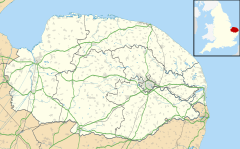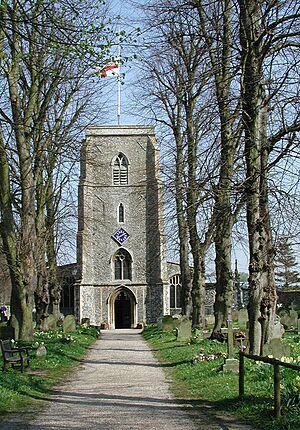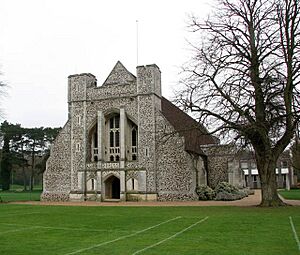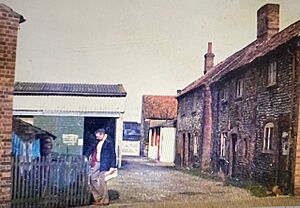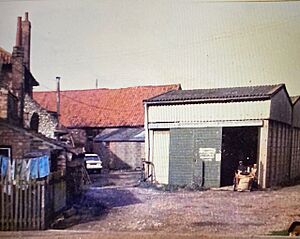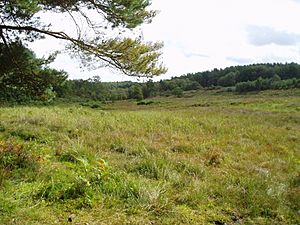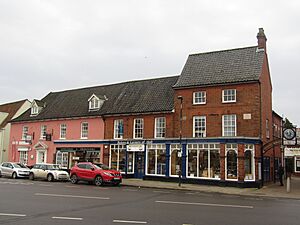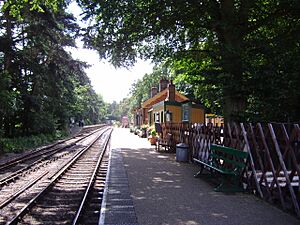Holt, Norfolk facts for kids
Quick facts for kids Holt |
|
|---|---|
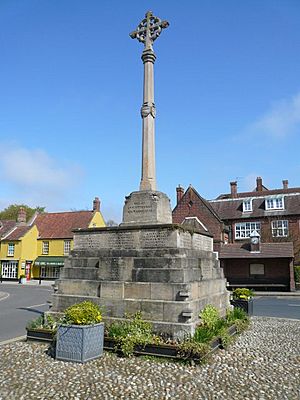 The war memorial in Holt's market place |
|
| Area | 12.19 km2 (4.71 sq mi) |
| Population | 3,810 (2011 census) |
| • Density | 313/km2 (810/sq mi) |
| OS grid reference | TG078388 |
| • London | 127 miles |
| Civil parish |
|
| District | |
| Shire county | |
| Region | |
| Country | England |
| Sovereign state | United Kingdom |
| Post town | HOLT |
| Postcode district | NR25 |
| Dialling code | 01263 |
| Police | Norfolk |
| Fire | Norfolk |
| Ambulance | East of England |
| EU Parliament | East of England |
| UK Parliament |
|
Holt is a lively market town and parish in the county of Norfolk, England. It's about 23 miles (37 km) north of the city of Norwich. Holt is also 10 miles (16 km) west of Cromer and 35 miles (56 km) east of King's Lynn.
The town has a population of about 3,550 people. If you include the surrounding area, the population was 3,810 in 2011. Holt is looked after by the North Norfolk District Council. It also has a special heritage railway station. This station is the end point of the North Norfolk Railway, which is famously known as the Poppy Line.
Contents
History of Holt
How Holt Began
The name Holt probably comes from an old Anglo-Saxon word for "woodland." This makes sense because Holt is on high, wooded ground. It's located where two old paths crossed, which was a great spot for a town to grow.
Holt is even mentioned in the famous Domesday Book from 1086. This old survey described it as a busy market town and a port. The nearby port of Cley next the Sea was considered Holt's port. The town had five watermills and twelve plough teams, showing it was a thriving place.
The first owner of the land was Walter Giffard. Later, it was passed to the De Vaux family. By then, Holt had a busy market and two yearly fairs. These fairs were held on April 25th and November 25th. Holt grew over time as an important place for trade. The weekly market, which had been running since before the 1080s, finally stopped in the 1960s.
The Great Fire of 1708
On May 1, 1708, a terrible fire destroyed most of Holt's old medieval town. The fire started at Shirehall Plain and quickly spread. Many of the town's timber houses were burned down in just three hours.
The church was also badly damaged. Its thatched roof was destroyed, and the lead melted from the windows. The flames even spread up the church steeple. Reports from that time said the fire moved so fast that butchers couldn't even save their meat from their market stalls. The damage to the town was estimated at about £11,000. People from all over the country sent donations to help Holt rebuild.
Georgian Style in Holt
Because most of the medieval buildings were destroyed, Holt was rebuilt in the popular Georgian style. This makes the town famous for its many beautiful Georgian buildings today. However, the town did repair and keep its old Norman parish church. This church is dedicated to St Andrew.
1968 RAF Mid-Air Crash
On August 19, 1968, two Royal Air Force (RAF) planes crashed in the sky over Holt. A Victor Tanker from RAF Marham and a Canberra bomber from RAF Bruggen in West Germany were involved. This happened after an electrical storm had damaged radar systems. Sadly, all seven airmen on board both planes died. A special memorial stone hangs inside Saint Andrew's Church to remember them.
Churches in Holt
Holt's old Church of England parish church is called St Andrew the Apostle. It might have started as far back as late Saxon times. It was rebuilt in the early 1300s in the Decorated Gothic style. A tower was added later in the same century.
The church had a thatched roof and was badly damaged in the great Holt fire of 1708. It was rebuilt between 1722 and 1727. Important people like Lord Townshend and Robert Walpole helped pay for the repairs. The church was restored again between 1862 and 1874.
The Methodist Church, on Obelisk Plain, was built between 1862 and 1863. It was designed by Thomas Jeckyll. The land was given by William Cozens-Hardy, who also paid most of the building costs.
The newest religious building is the Chapel of Gresham's School. It was designed by Maxwell Ayrton and built between 1912 and 1916. It's made of knapped flint and limestone. This chapel is now a Grade II listed building, meaning it's historically important.
Education in Holt
Gresham's School
Gresham's School is a well-known public school in Holt. It was started in 1555 by Sir John Gresham. Originally, it was only for boys, but it has been co-educational (for both boys and girls) since 1971. The school is located on the north side of the town.
Other Schools
Holt Community Primary School is a state primary school. It teaches children aged 4 to 11. The infant school was built in 1910, and the Junior School by 1928. In 1965, they joined together to form Holt County Primary School. The school has grown and changed over the years. In 1999, its name became Holt Community Primary School.
There isn't a state secondary school in Holt itself. Many children travel to Sheringham High School for their education from ages 11 to 16.
Local Places to See
Holt Hall
Holt Hall is a historic building set in an 86-acre (35 ha) estate. This estate includes old woodlands, green lawns, lakes, and gardens. The hall was built in the 1840s and made bigger in the 1860s.
It was owned by the Rogers family for many years. Holt Hall is a Grade II listed building. It was later owned by Norfolk County Council, who used it as an outdoor education center. In 2023, Gresham's School bought it. This was made possible with money from James Dyson, who used to be a student there.
Byfords
The building at 1–3 Shirehall Plain is thought to be the oldest house in Holt. Its cellar dates back to the 1400s. It survived the great fire of Holt in 1708 and another fire in the building in 1906.
For over 100 years, it was a hardware shop owned by the Byford family. Today, Byfords is a popular café, delicatessen, and B&B.
Blind Sam
"Blind Sam" is the local nickname for the Queen Victoria Jubilee Lantern. It's located in Obelisk Plain. From 1887, the year of Victoria's Golden Jubilee, until 1921, it stood in the Market Place. It had two jobs: to light up the market and to provide drinking water from two fountains.
The light was powered by the town's gas supply, which wasn't very reliable back then. That's why it got the nickname "Blind Sam." It was moved to Obelisk Plain in 1921 to make room for the war memorial. It was made by ironmongers in Glasgow and restored in the 1990s.
The Obelisk
The pineapple-topped obelisk in Holt is one of a pair of gateposts. They originally came from Melton Constable Park. The other gatepost was given to the town of Dereham in 1757. Each gatepost had the distances to different places carved into its stone.
At the start of Second World War, the people of Dereham dumped their obelisk down a deep well. They did this to prevent it from helping enemy invaders. It's still there today! The people of Holt simply painted their obelisk white. It remains in good condition.
Chapel Yard
Chapel Yard was the first big new shopping area in Holt in recent times. It was built in 1983. The project involved removing some 1950s warehouses. It also adapted old flint workers' cottages, a chapel, the old fire station, and a drill hall.
During the work, it was discovered that cottages 3, 4, 5, and 6 Chapel Yard were from the mid-1500s. They are the oldest known buildings in the area. They have since been given Grade II listed status. Their large chimneys have special pockets for drying grain. Old corn was even found in pots during the renovation.
The design of Chapel Yard, with its "yard" of shops, was later used for other developments in Holt. These include Apple Yard, Lee's Yard, Feather Yard, Hoppers Yard, and Franklyn's Yard. The design of a new supermarket in Holt, built in 1986, also used this traditional style. This supermarket, now Budgen's, won an award in 1986 for its design.
Former Landmarks
Water Tower
Holt's water used to be pumped from Spout Hills to a brick water tower. This tower was in Shirehall Plain. It was built in 1885 and was 56 feet (17 m) high. It could hold 15,000 gallons (68,000 litres) of water. You could even read the water level from the ground! The tower was used until 1955 and was taken down in 1957.
Windmill
A brick windmill was built in Holt in the late 1700s. When it was put up for sale in 1792, it was called "newly built." Many different owners used it until the early 1920s. The sails were removed in 1922, and the rest of the machinery in the 1930s. The brick tower was then used for storage. It was taken down in the 1970s because it was unsafe. Now, homes called Mill Court stand on the site.
Things to Do in Holt
Holt Country Park
Holt Country Park is a short walk from the town. In the past, it was a horse racing course, heathland, and farmland. Now, it's mostly woodland with Scots pine trees and native broadleaf trees. It has many plants and animals, including deer. The park has won a Green Flag Award every year since 2005, showing it's a well-managed green space.
Holt Lowes
The Lowes is an area of heathland about 120 acres (0.49 km2) to the south of Holt. It was set aside in 1807 for the poor people of Holt. They had rights to graze animals and take wood and gorse for their own use. However, the land wasn't very suitable, so it was probably not used much.
The Lowes was used for military training during the First World War. Today, it's open to the public, just like Holt Country Park. The Lowes has always been known as an important place for wildlife. It was made a SSSI (Site of Special Scientific Interest) in 1954. It's managed to prevent trees from taking over the heathland. Recent work has focused on clearing a large bog area. This bog supports special plants like sundews and several types of dragonfly. One type, the keeled skimmer, is found nowhere else in East Anglia!
Spout Hills
Spout Hills is a 14-acre (5.7 ha) green space. This area provided all the water for Holt, helping the town to grow. An old reservoir is still there, but the pumping station was taken down in the 1950s.
Bakers & Larners
Bakers & Larners is a department store located in Market Place. The Baker family has owned it continuously since the 1700s.
Getting Around Holt
Railway Travel
The closest train station to Holt is in Sheringham. From there, you can connect to the National Rail network via the Bittern Line to Norwich. Trains usually run every hour and are operated by Greater Anglia.
Railway History
Holt's first railway station opened in 1887. It was part of the Midland & Great Northern Joint Railway. Most of this railway network closed in 1959. However, the section from Melton Constable through Holt to Sheringham stayed open a few more years. It finally closed in 1964. The railway line was then cut back to Sheringham, which is now the closest national train station. Holt's original station was later taken down, and the town's bypass road now covers the site.
Heritage Railway
In 1965, soon after the line closed, the North Norfolk Railway was formed. Their goal was to bring part of the line back to life as a heritage steam railway. At first, it ran between Sheringham and Weybourne. Later, it was extended to the eastern edge of Holt, where a new station was built.
A horse-bus service called the Holt Flyer used to run between the town centre and the new station. It was timed to meet the trains. Now, an AEC Routemaster bus takes its place.
Future Plans for the Railway
There are plans by the Norfolk Orbital Railway to extend the heritage railway. They hope to bring it back towards the town centre and then on to Melton Constable and Fakenham.
Buses
Several local bus routes operate in and around Holt. These services are provided by Sanders Coaches.
Roads
The town is located on the A148 road. This road connects King's Lynn to Cromer.
Air Travel
Norwich International Airport is located on the northern edge of the city of Norwich.
Media in Holt
Television
Local news and TV shows for Holt are provided by BBC East and BBC Yorkshire and Lincolnshire on BBC One. They also come from ITV Anglia and ITV Yorkshire on ITV1. Television signals are received from either the Tacolneston or Belmont TV transmitters.
Radio
Local radio stations include BBC Radio Norfolk, Heart East, Amber Radio, Greatest Hits Radio East (which used to be North Norfolk Radio), and Poppyland Community Radio. Poppyland is a local community-based station.
Newspapers
The town is served by several local newspapers. These include The Holt Chronicle, North Norfolk News, and Eastern Daily Press.
Festivals and Events
Holt Festival
The Holt Festival began in the summer of 2009. It's an arts festival that runs for a week. The events include music, theatre, literature, cinema, and art.
Doctor Who Events
On Sunday, June 25, 2006, Holt was "invaded" by Daleks! This event was a celebration of BBC Television's classic science fiction series Doctor Who. The Doctor Who Midsummer Invasion brought many fans and some of the show's past stars to the town.
The event was organized by Planet Skaro, a local sci-fi store that has since closed. The main highlight of the day was a Dalek parade through the town centre. Because the first Invasion was so successful, another science fiction event took place in Holt on June 30, 2007.
Sports and Fun
Holt has a Rugby football club, which was started in 1961. The club's first game was played against West Norfolk on Gresham's School playing field. In the early days, the team used the White Lion Hotel for their changing rooms.
In 1967, the club bought 9 acres (3.6 ha) of land in nearby High Kelling. The club started playing their home games at their new facilities in 1969. At Bridge Road, the club has three full-size pitches and six smaller pitches for mini rugby. They also have a clubhouse built in 1970. There are changing rooms for up to 100 players. The club has three senior teams, a junior team, and mini rugby teams for ages 6 to 18.
Holt United Football Club was formed in 1894. It was one of the first members of the North Norfolk and Norwich League, which started in 1895. In 1927, the club joined the Norwich and District League and won it five times. In 1935, the club was in the Norfolk and Suffolk League. They didn't lose a league game until December that year, when they played Norwich City A at Carrow Road. Holt was the first amateur team to play at the newly built Carrow Road ground.
In 1985, Holt United left their ground at Jubilee Road. This land was sold to help pay for the new Sports Centre complex on Kelling Road. For one season, Holt played their matches at Gresham's School. In 1986, the club moved to their new ground at the Sports Centre. Four years later, they moved into junior football. As of July 2020, Holt United has three teams. The first team plays in the Anglian Combination, and the Reserves and Colts teams play in the North East Norfolk League.
Holt Harlequins Hockey Club (formerly Cromer Hockey Club) plays at the astroturf ground at Gresham's School.
Holt also has a King George's Field. This is a memorial to King George V.
Famous People from Holt
- Rex Malcolm Chaplin Dawson (1924–2021), a biochemist
- Geoffrey Gillam (1905–1970), a heart doctor
- Dr Thomas Girdlestone (1758–1822), a physician
- Sir John Gresham (1492–1556), a merchant and founder of Gresham's School
- Sir Richard Gresham (1494–1549), a merchant and Member of Parliament
- Billa Harrod (1911-2005), who worked to save old buildings
- John Holmes (1703–1760), an education expert
- Logie Bruce Lockhart (1921–2020), a writer and journalist
- Robert Pilch (1877–1957), a footballer
- Sir Matthew Pinsent (born 1970), an Olympic gold medallist in rowing
- Lewis Radford, who was a Vicar in Holt and later a Bishop in Australia
- Edmund Rogers (1823–1910), a journalist
- Sebastian Shaw (1905–1994), an actor
- Gareth Sibson (born 1977), a writer and broadcaster
- Sir William Stanley (1435–1495), a soldier
- Kieron Williamson (born 2002), a landscape artist
Images for kids
See also
 In Spanish: Holt (Norfolk) para niños
In Spanish: Holt (Norfolk) para niños


